View in other NatureServe Network Field Guides
NatureServe
Montana
Utah
Wyoming
Idaho
Wisconsin
British Columbia
South Carolina
Yukon
California
New York
Blue-eyed Darner - Rhionaeschna multicolor
State Rank Reason (see State Rank above)
The Blue-eyed Darner is currently ranked S2S4 as a "potential species of concern" in Montana because it is potentially at risk of extirpation in the state, due to limited and/or declining numbers, range and/or habitat, even though it may be abundant in some areas.
General Description
We do not yet have descriptive information on this species. Please try the buttons above to search for information from other sources.
Species Range
Montana Range
Range Descriptions
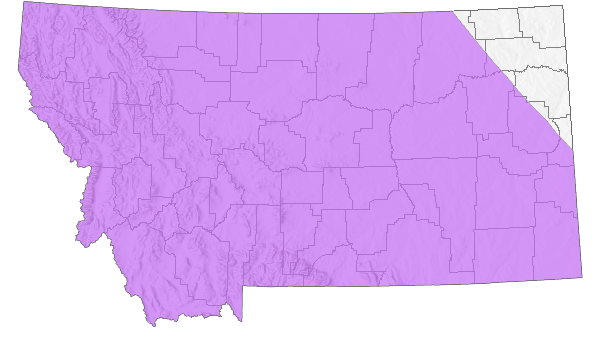
 Native
Native
Range Comments
This species is widespread in western North America, as far east as Wisconsin and south to Texas, northward to Bristish Columbia. It has been reported in the following states: Arizona (S5), California (SNR), Colorado (S5), Idaho (SNR), Iowa (S2), Kansas (SNR), Montana (S2S4), Nebraska (SNR), Nevada (SNR), New Mexico (SNR), Oklahoma (S4?), Oregon (SNR), South Dakota (SNR), Texas (SNR), Utah (S3?), Washington (S5), Wisconsin (SU), Wyoming (SNR) and BC in Canada (S5).
Observations in Montana Natural Heritage Program Database
Number of Observations: 117
(Click on the following maps and charts to see full sized version)
Map Help and Descriptions
Relative Density
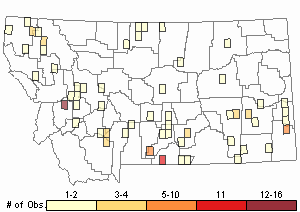
Recency
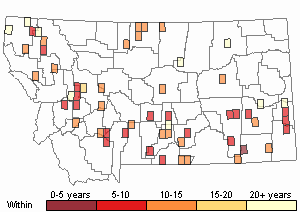
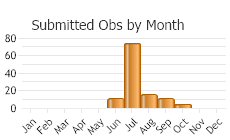
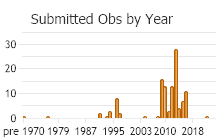
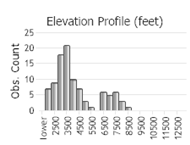 (Observations spanning multiple months or years are excluded from time charts)
(Observations spanning multiple months or years are excluded from time charts)
Habitat
The habitat of Blue-eyed Darners includes lakes, ponds, marshes, and slow streams with edge vegetation, as well as acid bogs. This species can also tolerate alkaline water conditions (Dunkle 2000, Nikula et al. 2002, Paulson 2009).
National Vegetation Classification System Groups Associated with this Species
Wetland and Riparian
Alkaline - Saline Wetlands
Peatland
Riparian and Wetland Forest
Riparian Shrubland
Wet Meadow and Marsh
Food Habits
Larvae feed on a wide variety of aquatic insects, such as mosquito larvae, other aquatic fly larvae, mayfly larvae, and freshwater shrimp. They will also eat very small fish and tadpoles.
Adult- The dragonfly will eat almost any soft-bodied flying insect including mosquitoes, flies, small moths, mayflies, and flying ants or termites.
Reproductive Characteristics
Male Blue-eyed Darners patrol large areas in irregular patterns along the shore and over open water, alternating with slow flights through the vegetation looking for females. Females oviposit above and below the waterline in stalks of dense emergent vegetation and floating plant stems and leaves (Dunkle 2000, Nikula et al. 2002, Paulson 2009).
Stewardship Responsibility
References
- Literature Cited AboveLegend:
 View Online Publication
View Online Publication Nikula, B., J. Sones, D.W. Stokes, and L.Q. Stokes. 2002. Stokes beginner's guide to dragonflies and damselflies. Boston: Little, Brown. 159 pp.
Nikula, B., J. Sones, D.W. Stokes, and L.Q. Stokes. 2002. Stokes beginner's guide to dragonflies and damselflies. Boston: Little, Brown. 159 pp.
- Additional ReferencesLegend:
 View Online Publication
View Online Publication
Do you know of a citation we're missing? Dunkle, S.W. 2000. Dragonflies through binoculars: A field guide to dragonflies of North America. New York, NY. Oxford University Press. 266 pp.
Dunkle, S.W. 2000. Dragonflies through binoculars: A field guide to dragonflies of North America. New York, NY. Oxford University Press. 266 pp. Maxell, B.A. 2016. Northern Goshawk surveys on the Beartooth, Ashland, and Sioux Districts of the Custer-Gallatin National Forest: 2012-2014. Montana Natural Heritage Program. Helena, MT. 114pp.
Maxell, B.A. 2016. Northern Goshawk surveys on the Beartooth, Ashland, and Sioux Districts of the Custer-Gallatin National Forest: 2012-2014. Montana Natural Heritage Program. Helena, MT. 114pp. Paulson, D.R. 2009. Dragonflies and Damselflies of the West. Princeton University Press, Princeton. 535 pp.
Paulson, D.R. 2009. Dragonflies and Damselflies of the West. Princeton University Press, Princeton. 535 pp. Sater, S. 2022. The insects of Sevenmile Creek, a pictorial guide to their diversity and ecology. Undergraduate Thesis. Helena, MT: Carroll College. 242 p.
Sater, S. 2022. The insects of Sevenmile Creek, a pictorial guide to their diversity and ecology. Undergraduate Thesis. Helena, MT: Carroll College. 242 p.
- Web Search Engines for Articles on "Blue-eyed Darner"
- Additional Sources of Information Related to "Insects"





